People Magazine, Bob Dylan, Ted Russell and Govinda Gallery
People Magazine celebrated Bob Dylan’s birthday this week with an in depth look at Ted Russell’s photographs of Dylan, including the first professional photographs taken of Dylan in November of 1961, just before the release of his first album. Writer Sam Gillette interviews Chris Murray about LIFE photographer Ted Russell and his now historic images of Dylan. Hats off to People for a great story honoring Dylan and Russell. Here it is!

By Sam Gillette | May 24, 2021 03:20 PM
Bob Dylan — the legendary singer-songwriter who won a Nobel Prize for his poeticism — turned 80 on Monday. In celebration of the artist’s 60 years on the folk-rock scene, PEOPLE has an exclusive look at rare photos of Dylan at the “genesis” of his career. Shot by photojournalist Ted Russell, the images include the earliest professional photographs ever taken of the young singer as he performed at Gerde’s Folk City and strummed his guitar in his Greenwich Village apartment in New York City in November 1961. Russell photographed Dylan again as he was seated next to James Baldwin at the NECLC’s Bill of Rights Dinner in November 1963, and while he was writing songs at his typewriter in his home in March 1964. By then Bob Dylan was “the voice of a generation,” says Chris Murray, who wrote the introduction to Russell’s photo book, Bob Dylan: NYC 1961-1964. “I can’t help but think about how Bob has endured,” says Murray in an interview with PEOPLE. “So many talented people, whether it be Jimi Hendrix or George Harrison or Kurt Cobain, were taken from us way too soon. But Bob has been a constant for us in the best sense of that word.”
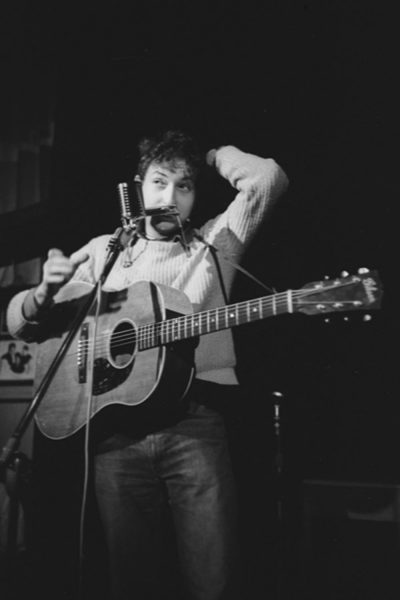
A Surprising Discovery
It’s a rare thing to discover unpublished photographs of music icons, explains Murray, the owner of Govinda Gallery in Washington, D.C. and a longtime champion of rock photography. So when Ted Russell called Murray in 2013, and asked if he could show him his box of rare Bob Dylan photographs, Murray immediately agreed.
“Here was this gentleman who is in his mid-80s, and we sit down at the table, and he pulls out a box of old photos. Not gorgeous gallery prints, if you will. They’re just a box of photos. I looked in this box, and I said, ‘Oh my God,’ ” he says. “It’s not very often that you can find an archive of unpublished photos of America’s greatest songwriter that have never been seen.”
With Murray’s help, Ted Russell’s photo book was published by Rizzoli the next year.
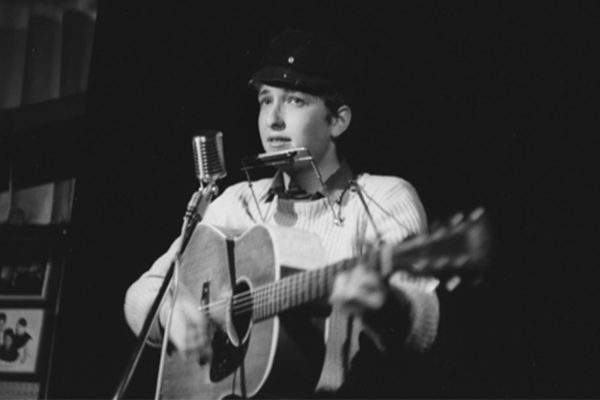
An Unknown Folk Singer
In November 1961, Bob Dylan performed at Gerde’s Folk City. After the performance, Russell asked Dylan if he could photograph him in his apartment for a photo essay about “the struggles of an up-and-coming folk singer trying to make it in New York City,” which he planned to pitch to national magazines, according to the preface in Bob Dylan.
Russell’s pitch to The Saturday Evening Post editors was a bust. While the editors were initially “enthusiastic” about the story idea, they didn’t like Dylan’s music, Russell writes.
‘They were all seated around a large oak conference table, waiting to hear the records, and as soon as I played the first one, they looked dismayed, and asked me if I was playing it at the correct speed,” he explains. “I tried at 33 rpm, and then 45 rpm, and they didn’t like either.”
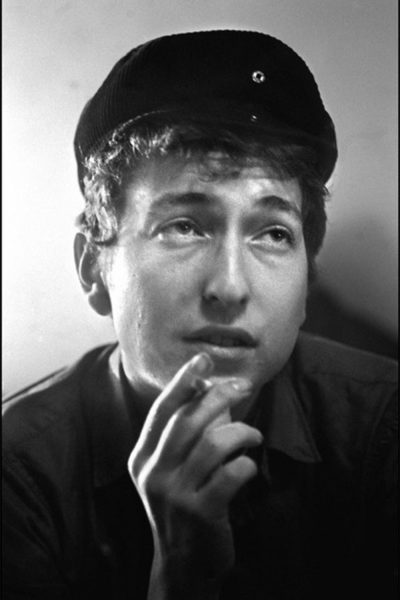
The Beginning of a Long Career
The editors may have passed on the story, but now Russell’s early images of Bob Dylan are treasured by his fans and fans of rock photography.
“These photos show the beginning of that incredible 60-year journey of songwriting and performing and recording and entertaining,” says Murray, whose favorite image is featured on the cover of the photo book. A young Bob Dylan smiles directly at the camera. “You see the whole future of Bob Dylan in that photo,” he continues.
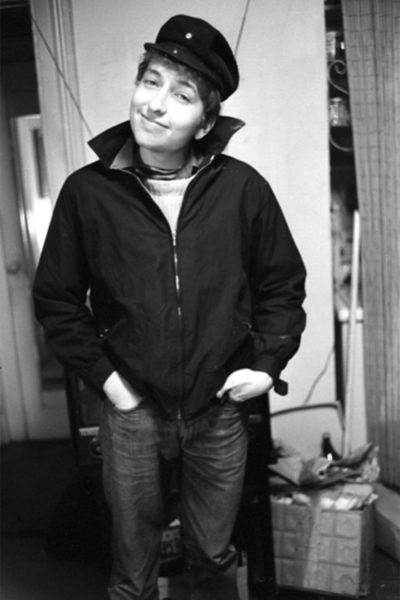
Just Bob Dylan
When Ted Russell photographed Bob Dylan in his apartment for the first time, the musician had just moved in with his girlfriend, Suze Rotolo.
“[Ted] said to Bob, ‘Hey, pretend I’m not here. Just go on and do what you do as if I’m not here,’ ” Murray explains of the photo shoot. “Sure enough, Bob just strummed his guitar in his bed.”
Murray loves the photograph (right) of Dylan smiling. He notes that next to Dylan is a box of items he hadn’t even unpacked yet.
“There were no stylists, no hair and makeup people, like there would be today,” says Murray of Russell’s “fly on the wall approach.” “It was just Ted with his camera observing Bob and shooting him.”
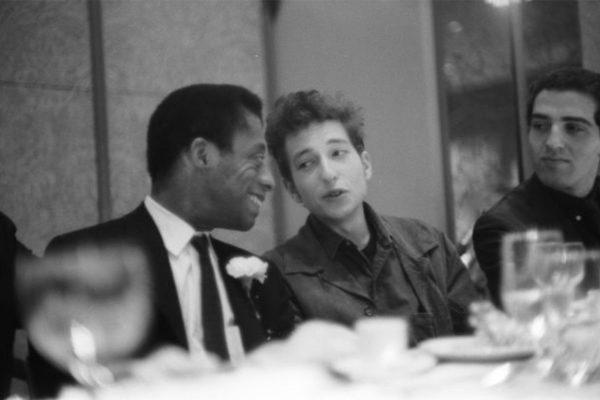
The Tom Paine Award
Russell didn’t photograph Dylan again until November 1963, just a few days before President John F. Kennedy’s assassination. Both Dylan and James Baldwin attended the NECLC’s Bill of Rights Dinner, where Dylan was given the Tom Paine Award. Russell was on assignment for LIFE magazine and photographed the two icons as they sat next to each other during the event.
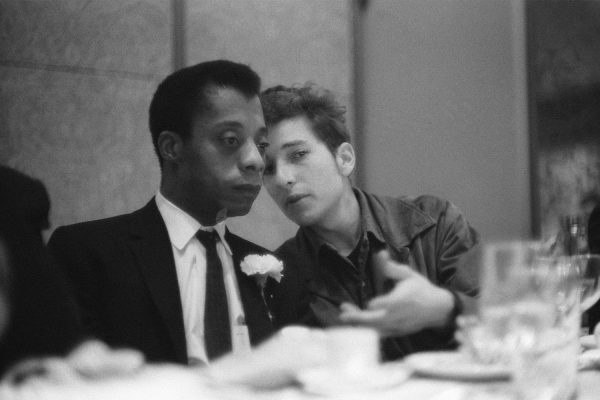
Two Icons Meet
“They clearly were enjoying each other’s company. There’s even one [photo] where Bob is at the lectern giving his thank you speech, and you see Baldwin looking up at him and smiling,” says Murray. “He clearly appreciated and was enjoying this young, idealistic singer, who by then had written ‘Blowin’ in the Wind,’ and ‘The Times They Are a-Changin’,’ some really important songs. Of course, Baldwin would have been very, very aware of that.”
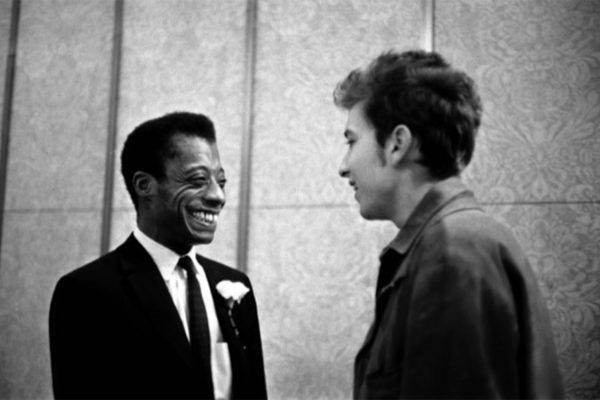
No Direction Home
Years later, when director Martin Scorsese released his 2005 documentary about Bob Dylan’s life, No Direction Home, he featured a number of Russell’s photographs from that historic night.
“It was a very significant event,” Murray explains.
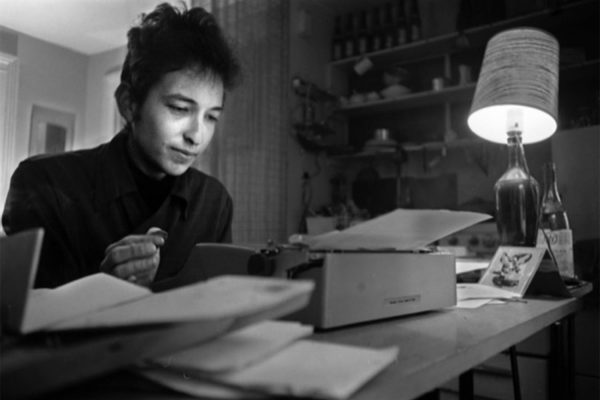
The Last Photo Shoot
Russell’s fourth — and last — photo shoot with Bob Dylan was also a LIFE assignment. In March 1964, Dylan was still living in the same Greenwich Village apartment. Russell photographed him at his typewriter, after his interview with a LIFE journalist.
“By then, [Bob Dylan] was a big, big deal. Still a folk artist. Hadn’t gone electric yet. But his songwriting had changed everything,” says Murray, who shared this never-before-published photograph (right) from the shoot with PEOPLE.
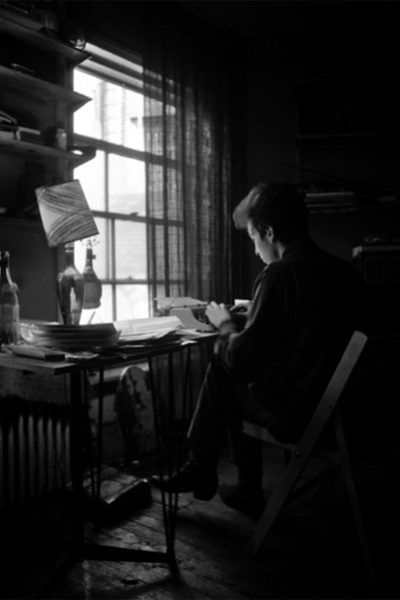
A Songwriter at Work
“Bob turned around and started writing. He used a typewriter,” Murray continues. “I’ve never, ever seen any other photos of Bob Dylan writing, and he is our greatest musical songwriter.”
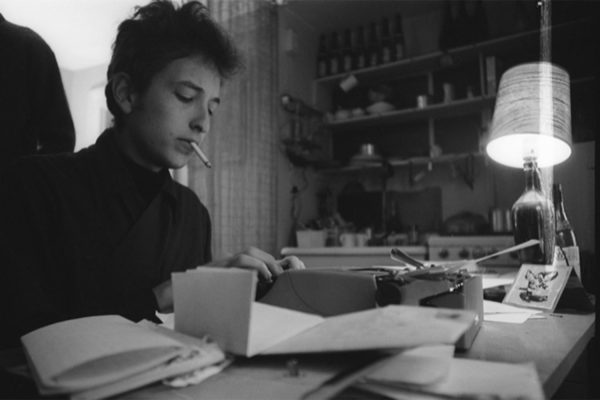
Capturing the Folk Music Scene
Beyond insight into the beginnings of Bob Dylan’s career, Russell’s photographs also capture the vivid folk music scene of New York City in the 1960s.
“[Bob Dylan] came from Hibbing, Minnesota to go to Greenwich Village,” says Murray, “because everybody knew there was this scene going on there.”
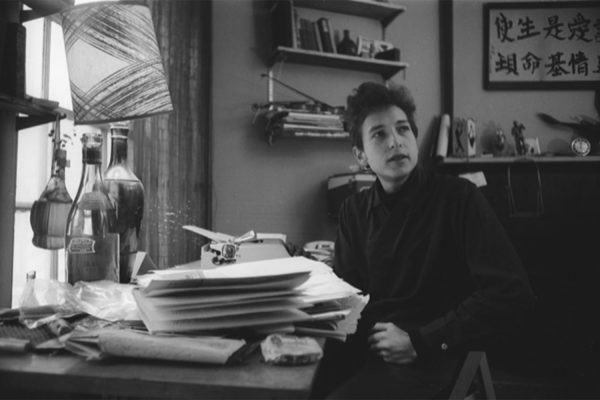
The Sound of Social Justice
Bob Dylan is a longtime champion of humanitarian causes — and so is his music.
“People were interested in ideas like peace, social justice,” Murray says of Bob Dylan’s connection to the cultural movement of the 1960s. “While Ted was photographing Bob during those three years, Bob wrote ‘Blowin’ in the Wind.’ He wrote ‘The Times They Are a-Changin’. So those photos reveal the environment, if you will, in Greenwich Village. The photos of him in Gerde’s Folk City, where he’s performing and singing these songs, this was the heart of the folk music movement. Bob was part of it.”

The Last Photograph
The last photo Russell took of Dylan is of the artist walking down the street before he grabbed a cab.
“I’m getting goosebumps. When you think of the cover photo of that young lad who looks like a kid or a cherub, he’s got the sweetest look, to the one when Bob is coming down the street, that’s November ’61 to November ’64,” says Murray. “What an amount of creativity in those few years. That folk music scene nurtured all of that, and New York nurtured it. Bob said, when he came to New York, ‘I knew this was the place I was meant to be.’ “

The Photo Book
Russell’s iconic photographs of Bob Dylan are featured in his book, Bob Dylan: NYC 1961-1964.